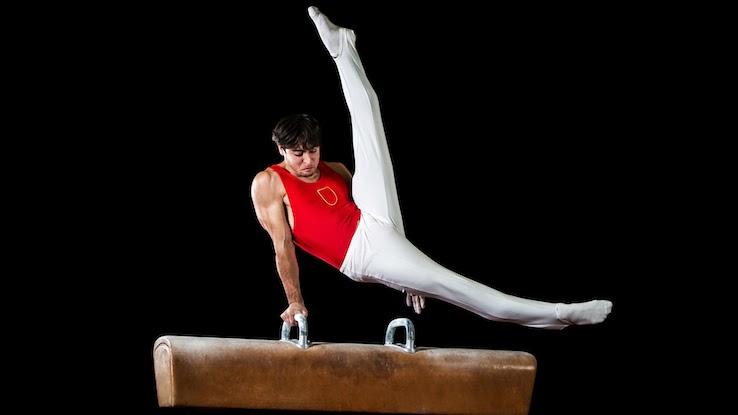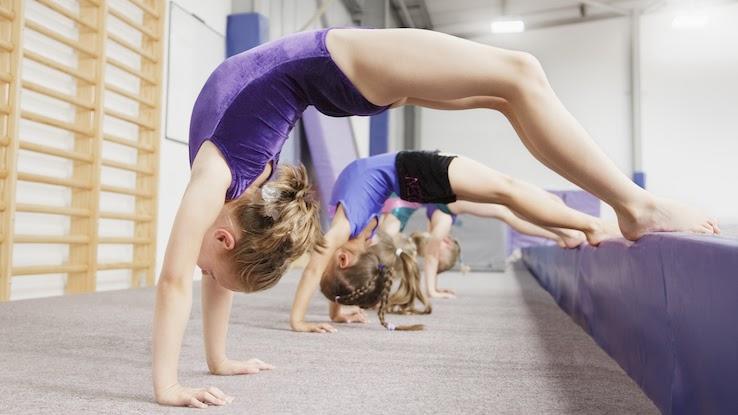What Are the 4 Phases of Gymnastics? Understanding the Gymnastics Conditioning List

Gymnasts are powerful, dedicated athletes who train hard in the gym on a regular basis. Mastering the incredible and often gravity-defying skills and moves we see during competitions isn’t easy. For gymnasts to perform at their best, they need a gymnastics program that can keep their bodies in great shape and strengthen their skills.
The phases of a gymnastics program are the progressive stages of a gymnast’s training routine. These phases include warmups, flexibility training, strength training and skill training. Let’s explore more about these four phases and some of the specific exercises gymnasts do to stay in the excellent shape required to succeed at this sport.
Types of Gymnastics
The way a gymnast trains depends largely on the type of gymnastics they plan to compete in. That’s why it’s essential to work with an experienced trainer who knows how to help a gymnast achieve the level of conditioning that’s tailored to the specific gymnastics skills the gymnast needs to know. There are actually seven different types of gymnastics: women’s artistic gymnastics, men’s artistic gymnastics, rhythmic gymnastics, trampoline, tumbling, acrobatic gymnastics and group gymnastics.

Women’s artistic gymnastics is likely the best-known type and consists of vault, uneven bars, balance beam and floor exercise. Men’s gymnastics involves floor exercise, pommel horse, still rings, vault, parallel bars and horizontal bar. In rhythmic gymnastics, gymnasts perform jumps, tosses, leaps and other moves with different types of accessories. Trampoline gymnastics requires gymnasts to perform flips and twists with every bounce.
Power tumbling is performed on a spring runway that has much more bounce than the typical floor exercise mat, which helps gymnasts maintain their ability to perform flips and other stunts. In acrobatic gymnastics, a two- to four-gymnast team performs various handstands and holds and balances on each other while members on the ground spot each other.
Group gymnastics is also a popular type in the United States. It’s usually performed competitively under the name TeamGym. Though TeamGym is not an official Olympic event, there are in-country meets as well as international invitationals. Local, regional and national competitions take place throughout the year. In TeamGym, athletes compete together in various competitions in groups of six to 16 gymnasts. The group may be all women, all men or mixed gender.
Gymnastics Conditioning List
Conditioning is necessary for helping gymnasts learn to complete different stunts. Doing different exercises properly encourages these athletes to focus on technique control. The following list is a recommended conditioning program from USA Gymnastics that a gymnast can work through after a general warmup:

- Press handstands (10 reps)
- Handstand push-ups (10 reps)
- Pike ups (10 reps)
- Cast handstands 10 spotted reps, 6 no-spot reps
- Pull-up, pull-overs (10 reps)
- Levers (10 reps)
- Rope climb (2 times)
- Leg lifts (20 reps)
- Around the world (10 reps)
- Still handstands against the wall — both sides (15 seconds)
- Body lifts over a horse
Gymnastics Warmup
When training as a gymnast, a proper warmup routine is vital for getting your muscles stretched and ready for intense activity. Warming up can also help prevent injuries, especially during practice. An effective warmup routine should include exercises that engage your entire body.

The routine should take about 10 minutes and start off with slow movements before moving on to increasingly more dynamic ones. You can do a pre-warmup by jumping rope or doing jumping jacks to raise your heart rate. Taking a light walk around the mat while doing wrist, head and arm rolls, as well as walking on your toes and heels, can help to stretch and activate most areas of your body. Jogging and other more dynamic (but still fairly light) exercises can end the warmup and leave you feeling strong and ready for practice.
Flexibility Gymnastics
As a gymnast, it’s also important to consistently work on your flexibility. Because gymnasts use their entire bodies, they have to make sure they’re warmed up and stretched properly and regularly to achieve the right range of motion. Without this, it can be difficult to pull off certain skills and tricks. They may also get point deductions on scores from judges at competitions if they’re unable to reach a certain position.

Some people think that just being able to do a split means you’re flexible. While that is a good stretch, gymnasts must also be flexible in other areas of their bodies, including their hips and shoulders. They need their hips to be able to do splits, jumps and leaps. Shoulder flexibility is also necessary for bridges, back handsprings and other stunts.
Gymnastics Strength Training
Another phase of gymnastics is strength training. Lifting weights in the sport isn’t for aesthetics. “Training to increase muscle size and strength is important, but maximum strength from minimum size is the most important training goal,” writes James J. Major of the Motor Behavior Laboratory at the University of Utah’s Department of Exercise and Sports Science.

Unlike in bodybuilding, the quality of the reps is more important than the quantity. Gymnasts need to have proper form during their strength training to ensure they’re strengthening the right muscles without injuring themselves. Consistency in strength training is also key, but gymnasts should change the volume, intensity and frequency of the reps to challenge their bodies. Rest is also important to give muscles time to recover.
Gymnastics Skill Training
The last phase, and the phase everyone wants to get to, is skill training. Trainers help gymnasts control their body weight to conduct different movements and skills. As with strength training, you have to be consistent with skill training in order to build up your strength and ability.

From the beginning, gymnasts are trained on the six basic body positions in gymnastics: the arch, pike, tuck, straddle, hollow and lunge. Being able to jump over a balance beam or perform high-level stunts takes years of practice. Women typically train for the vault, uneven bars, balance beam and floor exercise, while men perform the vault, floor exercise, parallel bars, horizontal bar, pommel horse and still rings. Dance training is also considered a great skill for gymnasts.
Gymnastics is a highly physical sport that can take a toll on the body. However, with the right warmup and training routine, a gymnast will be prepared to shine on the competition floor.





